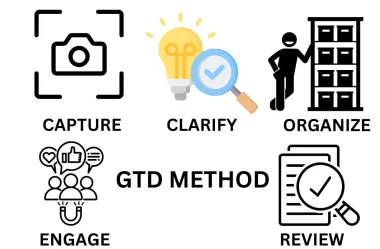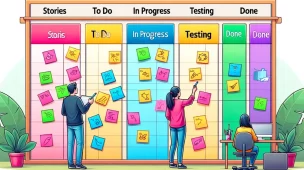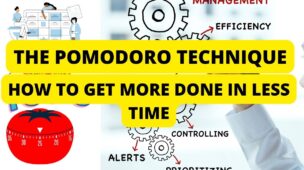Table of Contents
Introduction: Unlocking Your Productivity Potential with GTD
The Power of Effective Task Management (Getting Things Done Method)
Welcome to the ultimate guide on mastering productivity using the renowned “Getting Things Done” (GTD) method. In a world where distractions are as abundant as opportunities, staying focused and organized is key to achieving your goals. GTD is not just another time-management system; it’s a mindset shift that empowers you to take control of your tasks and priorities.
Embracing the GTD Philosophy
At its core, GTD is all about decluttering your mind by externalizing your thoughts and commitments. Imagine having a mental space free from the incessant buzz of unfinished tasks and looming deadlines.
By following the simple yet profound principles of GTD, you can transform overwhelm into clarity and chaos into calmness. It’s not about working harder but smarter, making deliberate choices about where to focus your time and energy.
The Promise of Peak Performance
By adopting the GTD approach, you’re not just managing tasks; you’re optimizing your performance in every aspect of life. Whether it’s completing work projects efficiently, maintaining a harmonious work-life balance, or pursuing personal passions without feeling guilty, GTD equips you with the tools to thrive in today’s fast-paced world.
Are you ready to unleash your full potential? Let’s dive deep into the transformative world of getting things done!
Unpacking the GTD Method: Your Path to Productivity
Exploring the GTD (Getting Things Done Method)
Ah, the mystical art of “Getting Things Done,” a productivity system created by David Allen that promises to transform your chaotic to-do list into a well-oiled machine. At its core, GTD is all about capturing, organizing, and executing tasks in a systematic way to free up mental clutter and boost efficiency. Think of it as your personal roadmap to success in a world filled with distractions and endless responsibilities.
Book: Getting Things Done: The Art of Stress-free Productivity by David Allen
The Significance of Task Management
In today’s fast-paced world, effective task management is not just a fancy term thrown around by corporate gurus; it’s the secret sauce to unlocking your full potential. By mastering the art of juggling tasks with finesse, you pave the way for increased productivity, reduced stress levels, and more time for activities that truly matter. Imagine having a clear mind and a clear desk where every task has its designated spot—that’s the power of effective task management at play.
The GTD Framework: Your Roadmap to Productivity
Five Stages of Getting Things Done Method (GTD): Capture, Clarify, Organize, Reflect, and Engage
So, you’ve decided to dive into the exciting world of the Getting Things Done method! Let’s break it down for you. The first stage is “capture”, where you jot down every single task or idea that pops into your head.
This could be anything from “Buy milk” to “Plan vacation to Bora Bora.” No task is too big or too small for your trusty capture system. Next up is “Clarify”.
This is where you go through each item you’ve captured and decide what exactly it means and what needs to be done about it. Is it a quick task that will take less than two minutes?
Then go ahead and tackle it right away! Otherwise, decide if it’s something that can be delegated or needs further planning.
Once you’ve clarified everything, it’s time to “Organize”. Create a system that works for you—whether it’s physical folders, digital apps, or a combination of both.
Sort tasks into categories like work, personal, errands, etc., and make sure everything has a designated place. Your organized system will be your best friend in staying on top of things.
Key Principles: Inbox Zero, Next Actions, Contexts
Now let’s talk about some key principles that will supercharge your productivity game with GTD. First up is “Inbox Zero”—the holy grail of email management.
The idea here is simple: keep your email inbox empty by either responding immediately (if the task takes less than two minutes) or categorizing emails into actionable items for later processing. Next on our list is “Next Actions”.
This principle emphasizes breaking down tasks into the very next physical action needed to move them forward. Instead of vague goals like “lose weight,” think specific actions like “research gym memberships” or “schedule a workout session.” By focusing on actionable steps, you’ll find yourself making progress faster than ever before.
We have “contexts”—a game-changer in organizing your tasks based on where and when they can be completed most effectively. Whether it’s tasks that require internet access (like replying to emails) or tasks best tackled during specific times (like calling during office hours), assigning contexts helps streamline your workflow and ensures nothing slips through the cracks.
Setting Up Your Task Management System (Getting Things Done Method)
When it comes to implementing the Getting Things Done (GTD) method in your daily life, the first step is setting up a task management system that works for you. Whether you prefer the tactile feel of pen and paper or the convenience of digital tools, your system should be reliable and easily accessible.
Consider using a physical planner or notebook for those who enjoy writing things down by hand. Alternatively, explore digital platforms like task management apps or software that offer features such as reminders and categorization.
Breaking Down Tasks with the Two-Minute Rule
The two-minute rule is a game-changer when it comes to tackling tasks efficiently. The concept is simple: if a task can be completed in two minutes or less, do it immediately.
By applying this rule, you avoid accumulating small tasks that can clutter your to-do list and drain your mental energy. Whether it’s responding to an email, making a quick phone call, or tidying up your workspace, taking care of these mini-tasks promptly frees up space for more significant priorities.
Creating Context-Based Lists for Efficiency
To streamline your workflow and enhance productivity, consider creating context-based lists that cater to different aspects of your life. For example, have separate lists for work-related tasks, personal errands, household chores, and so on. By organizing tasks based on their context or location (such as “at home,” “at office,” “online”), you can focus on completing relevant activities at the right time and place without feeling overwhelmed by a jumbled list of to-dos.
Mastering Productivity with GTD (Getting Things Done Method)
Weekly Reviews: Keeping Priorities in Check
Ah, the weekly review – a time to pause, reflect, and recalibrate. This GTD technique is like hitting the reset button on your productivity. Take a moment at the end of each week to assess what you’ve accomplished, what’s still pending, and what new tasks have cropped up.
By revisiting your priorities and goals regularly, you ensure that you stay on track and adjust your focus as needed. It’s a bit like fine-tuning the engine of a well-oiled machine.
Mind Mapping Magic: Unleashing Creativity
Imagine your brain as a vast landscape waiting to be explored. Mind mapping is your trusted compass in this sea of ideas. Whether you’re planning a project or brainstorming solutions, this GTD technique helps organize thoughts visually and uncover unexpected connections.
Start with a central idea and let branches sprout with related concepts or tasks. Before you know it, you’ll have a roadmap of your thoughts that not only clarifies your path but also sparks new insights along the way.
The 2-Minute Rule: Conquering Quick Wins
Ah, the power of small victories! The 2-minute rule is like having a secret weapon against procrastination lurking in your back pocket. The premise is simple: if a task can be completed in two minutes or less, do it immediately.
By tackling these quick wins head-on, you eliminate clutter from your to-do list and build momentum for more substantial tasks ahead. It’s amazing how such seemingly insignificant actions can snowball into significant progress over time.
Conquering Common Challenges in Using GTD (Getting Things Done Method)
Dealing with Procrastination and Prioritization Issues
Procrastination, that sneaky little productivity thief, can derail even the most well-organized GTD system. One key to overcoming procrastination is breaking tasks down into smaller, more manageable steps.
This not only makes them less daunting but also allows you to tackle them one at a time without feeling overwhelmed. Additionally, setting realistic deadlines for each task and holding yourself accountable can help combat the temptation to procrastinate.
Prioritization is another crucial aspect of successful task management within the GTD framework. When faced with multiple tasks vying for your attention, it’s essential to prioritize based on urgency and importance.
One effective strategy is using the Eisenhower Matrix, which categorizes tasks into four quadrants: urgent & important, important but not urgent, urgent but not important, and neither urgent nor important. By employing this method, you can ensure that you focus on high-priority tasks while still addressing other responsibilities in a systematic manner.
Managing Interruptions and Distractions Effectively
In our fast-paced world filled with constant notifications and distractions, staying focused on our tasks can be a Herculean feat. To combat interruptions effectively within the GTD methodology, consider implementing time-blocking techniques. Designate specific blocks of time for focused work without any interruptions or distractions.
During these periods, turn off notifications on your devices and create a conducive environment for deep concentration. Distractions come in many forms, from social media notifications to unexpected phone calls, but by proactively managing them using GTD principles, you can regain control over your productivity.
One useful approach is utilizing the “two-minute rule,” where if a distraction will take two minutes or less to address (such as responding to a quick email), handle it immediately so it doesn’t linger in your mind and disrupt your workflow. By setting boundaries around interruptions and establishing clear guidelines for when you engage with them, you can maintain focus while navigating the tumultuous seas of modern-day distractions.
Advanced Tips for GTD (Getting Things Done Method) Mastery
Incorporating Technology Tools for Seamless Task Tracking
In this modern age of digital advancements, leveraging technology can significantly elevate your productivity game when it comes to implementing the GTD method. There are a plethora of task management apps available that can streamline your workflow and help you stay organized.
From popular options like Todoist and Trello to more specialized tools like Evernote and Asana, finding the right app that aligns with your preferences and workflow is crucial. These apps allow you to capture tasks, set reminders, categorize projects, and collaborate with team members effortlessly.
Furthermore, some advanced features in these apps even offer integrations with other tools such as calendar applications, email clients, and cloud storage services. This integration ensures that all aspects of your tasks and projects are interconnected and easily accessible from one centralized platform.
By syncing your task lists across devices, you can seamlessly transition between workspaces without missing a beat. Embracing technology not only enhances efficiency but also provides a convenient way to track progress, measure productivity metrics, and adapt to changing priorities in real time.
Utilizing Energy Levels for Optimal Productivity
Understanding your natural energy fluctuations throughout the day is key to optimizing your productivity using the GTD method. Each individual has peak times when their focus is sharp, creativity flows effortlessly, and motivation is at its peak. By identifying these high-energy periods, you can strategically assign tasks that require intense concentration or creative thinking during these times.
For instance, if you are a morning person with a peak focus in the early hours, allocate complex problem-solving or strategic planning tasks to this time slot for maximum efficiency. Conversely, during low-energy periods where mental fatigue sets in or distractions are more prevalent, assign lighter tasks such as organizing files or responding to routine emails.
By aligning your task list with your energy levels throughout the day, you not only enhance productivity but also maintain a sustainable pace of work without experiencing burnout. Remember that everyone’s energy patterns differ; experiment with different schedules to find what works best for you and adjust accordingly based on feedback from your performance.
Leveraging Delegation and Outsourcing When Necessary
One of the key principles of effective time management within the GTD framework is recognizing when certain tasks can be better handled by others. Delegation involves assigning responsibilities to colleagues or team members who have the expertise or bandwidth to complete those tasks efficiently.
By acknowledging your own limitations and prioritizing high-impact activities that align with your strengths, you free up valuable time for more critical initiatives while ensuring optimal results across all areas of work. Additionally,
outsourcing non-core activities like administrative tasks, design work
or social media management allows highly skilled professionals outside
your organization to handle specialized functions,
thus increasing overall efficiency. Outsourcing also provides flexibility in resource allocation,
enabling teams to focus on core competencies
and strategic objectives without being bogged down by peripheral duties.
When considering delegation or outsourcing,
clear communication and defined expectations
are essential to ensuring seamless collaboration
and successful outcomes. By embracing delegation,
and outsourcing intelligently, you empower yourself
to concentrate on impactful pursuits that drive progress
while maintaining a harmonious balance of workload distribution within your sphere of influence.
Embracing Enhanced Productivity
In adopting the GTD method, you are opening the door to a realm of enhanced productivity and efficiency. By implementing the principles of GTD, you are not just managing tasks; you are actively shaping your workflow to align with your goals and priorities. The beauty of GTD lies in its ability to bring clarity amidst chaos, allowing you to focus on what truly matters without feeling overwhelmed by the sheer volume of tasks at hand.
The Benefits Unveiled
Recapping the benefits of adopting the GTD method is like unwrapping a gift that keeps on giving. Increased productivity, reduced stress levels, heightened focus, and improved time management skills are just a few of the gems waiting for you as you delve deeper into the world of GTD.
Imagine feeling more in control of your day, effortlessly moving from one task to another with purpose and direction. That sense of accomplishment at the end of each day is not a distant dream but a tangible reality with GTD by your side.
Begin Your Journey
As we wrap up our exploration of the GTD method, remember that Rome wasn’t built in a day – and neither will your mastery of this productivity system be instantaneous. Start small, implement one principle at a time, and gradually integrate GTD into your daily routine.
Celebrate each small victory along the way and don’t be discouraged by setbacks; they are simply opportunities for growth and learning. Trust in the process, stay committed to your goals, and watch as GTD transforms not only how you work but how you live – with purpose, efficiency, and joy.
FAQ Getting Things Done (GTD)
The GTD method is a productivity system designed to help you manage your tasks and commitments in a stress-free manner, focusing on organizing tasks into actionable items.
If you’re feeling overwhelmed with multiple tasks and deadlines, the GTD method can help you organize, prioritize, and focus on one task at a time, leading to better efficiency and less stress.
The GTD method was developed by David Allen and first introduced in his book “Getting Things Done: The Art of Stress-Free Productivity.
The five steps are Capture, Clarify, Organize, Engage, and Review, each designed to help you process your tasks and commitments more efficiently.
By following the GTD method, you can clear your mind, prioritize tasks, and focus on completing them one at a time, which boosts productivity and reduces procrastination.
Yes, GTD is designed to create a more organized approach to handling tasks, which can significantly reduce stress levels by making workloads more manageable.
While GTD has universal principles, its effectiveness can vary based on individual work habits and preferences. It’s adaptable, allowing you to tailor it to your personal needs.
You can start with simple tools like a notebook and pen for capturing tasks, or use digital tools like task management apps to organize and track your progress.
Regular reviews are crucial. David Allen suggests a weekly review to update your lists and ensure your system reflects your current priorities and commitments.
The Getting Things Done (GTD) method can be applied to both personal and professional aspects of life.












